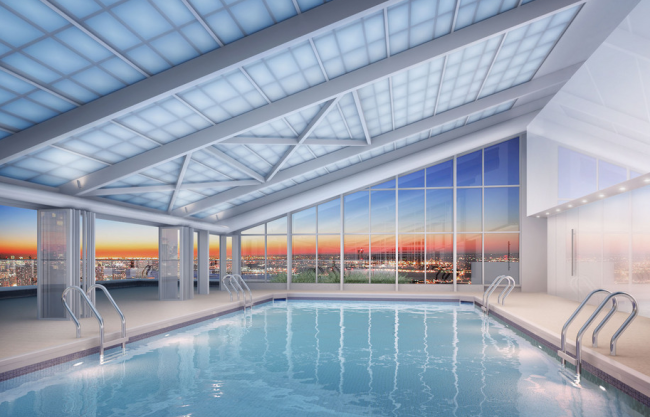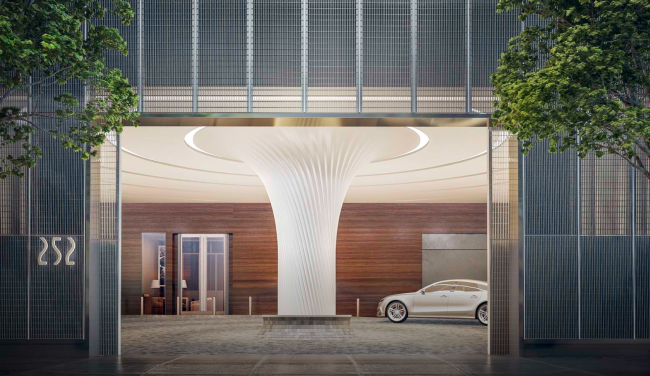Building amenities: What do tenants use, and what do they ignore?

An outdoor area at URBY, a 900-unit development on Staten Island.
In their quest to attracted moneyed renters and buyers, new developments are perpetually striving to keep their finger on the pulse of what New Yorkers most desire when it comes to amenities.
If you think having a dishwasher in your apartment sounds like heaven, you’ll be astounded by what’s on offer in some of the city’s high-end properties. Real estate brokers told the New York Observer, for instance, that a mere gym isn’t enough anymore: Now some buildings boast yoga and spin rooms, lap pools, basketball courts, and rock climbing walls.
But are such building bonuses actually used, or do tenants just like the idea—and the image—of having them on premises? We spoke to property managers and other real estate experts to find out what New Yorkers are demanding and discarding these days.
What’s hot
• Elaborate outdoor areas--maybe
New York City has had its own back-to-the-land movement in recent years, with New Yorkers increasingly game for getting their hands dirty; consider how mini-farms like Brooklyn Grange have proliferated throughout the boroughs.
What this means is that prospective buyers and renters want their buildings to not only offer outdoor spaces, but also to facilitate activities within those spaces. Angela Ferrara, executive vice president with The Marketing Directors, notes that Staten Island mega-development Urby includes a 4,500-square foot garden and a “farmer-in-residence.”
“People are looking more towards organic cooking and foods,” Ferrara explains, and Urby residents can reserve the opportunity to have a dinner made for them from the bounty of the land. “The farmer speaks to you about what's behind the food and combinations, and how you can grow it yourself.”
Roof decks, too, are now a “must have,” Ferrara says, with residents wanting not just to lounge, but also to have fire pits and sprinklers available during the summer months.
AM New York has a roundup of some of NYC’s most elaborate, covetable outdoor spaces; one property in Long Island City comes with a sun deck, tennis court, beach volleyball court, and dog run.
Interestingly, while luxe roof decks are on many greenery-deprived New Yorkers’ wish lists, they don’t necessarily take advantage of the amenity once they have it. Doug Perlson, founder and CEO of Real Direct, says “there are roof deck people and then there aren’t. About 10 to 15 percent of residents will actually use the common outdoor spaces.”
For the rest, he adds, it’s about having the option to sun themselves, even if it rarely comes to pass.
• Work-from-home spaces
According to Fast Company, the number of freelancers throughout the country rose by a million from 2014 to 2015, which means more people than ever are working from home. Plus, being perpetually reachable via technology blurs the boundaries between business and leisure time, leading many apartment dwellers to demand a comfortable in-building space for working.
For New Yorkers who aren’t ready to go full-throttle and move into WeWork’s new live/work buildings, many developments now offer amped-up business centers that spare the self-employed the additional cost of renting a space in a co-working facility.
“It's part of the culture that came about when offices started taking away cubicles and making space more open so employees could work with each other,” says Eric Benaim, founder of Modern Spaces. “Like what WeWork does with foosball tables, free beer, and a kitchen area for employees, a lot of developers are now applying that mentality to their residences.”
Brendan Aguayo, senior vice president and managing director of Halstead Property Development Marketing, agrees that business centers are increasingly in demand with clients: “Any time you can offer a dedicated space for working, with printers, WiFi, and a place to charge computers and phones, it’s going to get used a lot,” he says.
• Opportunities for community building
New Yorkers are not traditionally thought of as neighborly, but their supposed standoffishness may be a thing of the past. Perhaps in tandem with the ascendance of shared work spaces, many buyers and renters are now asking for more social experiences at home, too. “A lot of people like having a lifestyle guru or manager schedule various types of classes or activities," says Benaim. "It’s like team building, but for tenants.”
And developers are getting creative with how they facilitate in-building socializing.
At 225 East 39th Street, a Murray Hill luxury rental building currently under construction, there will be bocce ball and a shuffleboard court. “Those are old-school types of amenities that are coming back,” Ferrara says. “It’s super fun and doesn’t take up a lot of room.”
Screening rooms fit into this too, Benaim says. “Apartments are a lot smaller than they were years ago, so developers put a lot more emphasis on design and functionality. Lounges and media rooms are multi-functional, and we’re seeing buildings that have weekly Netflix nights, Superbowl parties, and election debate-watching.”
And while adults may be increasingly drawn to college dorm-style social events, there’s an even greater need for tweens and teens to have a room of their own to hang out in.
“There aren’t many outlets for teens. They want to do something fun, but they don’t want to be home with Mom and Dad,” Ferrara points out. Dedicated spaces for this age group are on the rise, in terms of popularity. The Modern in Fort Lee (fyi, a Brick sponsor), for instance, offers a tween lounge with karaoke and gaming.
What’s rarely used (but still requested, nonetheless)
• Cold storage
Refrigerated storage spaces were high in demand after the debut of Fresh Direct, but now that there are multiple options for ordering groceries in the city—as well as more convenient time windows for their delivery—cold storage has fallen out of fashion.
“It was very hot a couple years ago with the advent of Fresh Direct, but now that it’s more of a regular thing and lots of places are delivering, having that room might not be as important as people once thought it was,” Perlson says.
Aguayo notes that while many clients still seem to see storage as one of the basic amenities a building should offer, it is getting used a lot less. Even standard storage spaces tend to remain empty: “We end up with leftover storage units—it’s not typical that we're selling the storage room set aside for every apartment.”
• Fitness facilities
If you’re continuously failing to live up to a personal pledge of hitting the gym regularly, rest assured that you’re not alone: Thinking you’re going to work out a certain amount, and then actually following through on it, are two very different things for most New Yorkers.
“The whole idea for a gym as a business proposition is that more people are going to sign up than use it,” Perlson says. “That applies as well to buildings.”
Benaim agrees: “People like to be able to say, ‘I live in a building with a pool and a gym.’ I have a pool and a gym in my building and I've been here eight years, and I've used the pool maybe three times and the gym maybe six times.”
So even as fitness-related amenities grow ever more elaborate—the Aldyn, for instance, on the Upper West Side, comes with a 38-foot rock climbing wall, a La Palestra brand athletic club, and a bowling alley—many residents continue to use these perks only sparingly.
It seems that the more specialized an amenity, the higher the risk that it will go unused. One perk that might be worth jettisoning in favor of something else is the golf simulator. Of these devices, Ferrara says, “It becomes a novelty pretty quickly, and it ends up being a room that can only be used for one thing. People love it in the beginning, but don’t use it in on a regular basis.”
Golf simulators aside, Aguayo says that when it comes to what’s considered a “fundamental” amenity, it’s “first and foremost a gym.” That said, he adds that for many renters and buyers, “a pool is a sexy amenity, but not practical.”
This doesn’t mean developers should ditch their plans to include fitness-related amenities, though. Perlson says that even when they're not used, they're still something that many prospective residents require. “They recognize they don’t use it as much as they should, but they feel that by having it on premises, the likelihood of usage will increase," he says.
Perhaps the most important benefit of living in an amenity-packed building, then, is the sense of endless potential—whether it’s realized or not—that comes with all those extras.
You Might Also Like




























